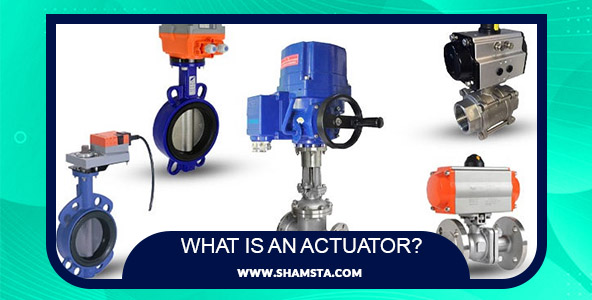
An actuator is a vital component in industrial and mechanical systems that is responsible for converting control signals into mechanical movement. These devices can operate electrically, hydraulically, or pneumatically and are used in a wide range of industrial and non-industrial applications. An actuator is an actuator or mechanism that converts control commands into actual movement. This movement can be linear (forward and backward) or rotational. An actuator is used with names such as solenoid valve, electric actuator and workshop valve automation. Its types include electric, hydraulic, pneumatic, and... actuators, which are used in the automotive, oil and gas, and food industries. In this article, we will examine the types of actuators, their applications, and how they work.
Electrical actuators work using electrical power. Electrical Actuators are a type of actuator that uses electrical energy to create linear or rotary motion. This movement from electrical energy is usually created by smaller electric motors such as DC motors or stepper motors. These types of actuators include electric motors that create rotary or linear motion. The characteristics of an electric actuator are high accuracy (suitable for applications that require precise motion control), easy control (can be controlled using electronic systems), and high speed and responsiveness. Electric actuators are used in robotics and industrial automation, medical equipment, and HVAC systems.
Receiving an electrical signal: An electrical signal is sent from the controller to the electric motor.
Converting the signal into motion: The electric motor starts rotating or moving linearly according to the received signal.
Precise control: Using a variety of sensors and feedback systems, the position and speed of movement are controlled.
Linear Actuator: This type of electric actuator produces linear motion. The output of this actuator is similar to the reciprocating motion of a piston in a cylinder. Depending on the type of motor and power transmission mechanism, linear actuators can provide a wide range of force and speed.
Rotary Actuator: This type of electric actuator produces rotary motion. The electric motor in this type of actuator is usually connected to a gearbox to increase the output torque. Rotary actuators are available in various degrees of rotation, from a few degrees to a continuous 360 degrees.
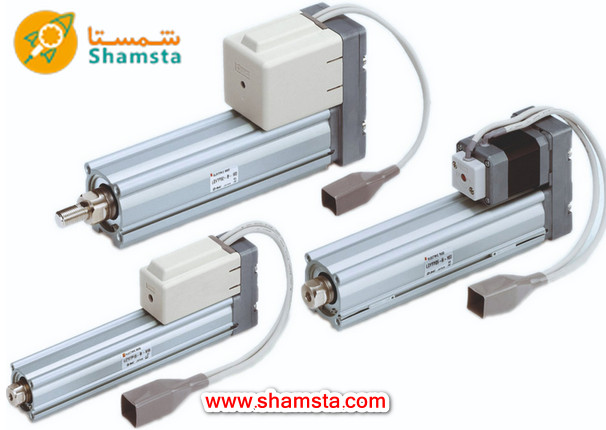
Related article: types of industrial valves
Hydraulic actuators operate using pressurized fluid. These types of actuators have great power and are suitable for applications that require high force. The characteristics of hydraulic actuators are high power and the ability to produce high force, stability and reliability, and good control over speed and position. Electric actuators are used in heavy machinery, construction equipment, and transportation systems.
Receiving a hydraulic signal: The hydraulic signal is sent from the controller to the hydraulic pump.
Converting the signal into motion: The hydraulic pump transfers the pressurized fluid to the hydraulic cylinder.
Creating a large force: The pressurized fluid causes the piston in the hydraulic cylinder to move.
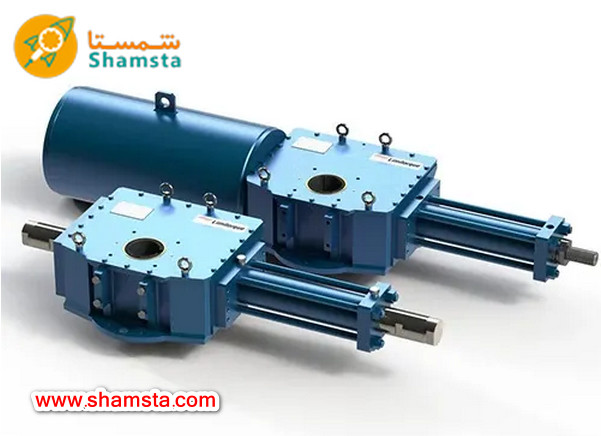
Pneumatic actuators operate using compressed air. These types of actuators are fast and suitable for applications that require repetitive and rapid movements. It is a part of a device that uses compressed air energy to create linear or rotary motion. These types of actuators are usually lighter, quieter, and faster than other types of actuators, and for this reason they are widely used in many industrial applications. In pneumatic actuators, compressed air is produced by an air compressor and controlled through solenoid valves. By applying electric current to the solenoid valve, the air passage is opened and compressed air enters the actuator cylinder. The actuator cylinder is similar to a hollow cylinder with a piston moving inside it. The compressed air exerts force on the piston inside the cylinder, causing it to move back and forth. This linear motion of the piston can be converted into linear output motion with the help of a rod connected to it or into rotary output motion by special mechanisms. The features of the pneumatic actuator include rapid response to control signals, compatibility with hazardous environments without producing sparks, and suitability for flammable environments, as well as its simple structure and easy maintenance. The applications of the pneumatic actuator are in industrial automation systems, production and packaging lines, and laboratory equipment. The pneumatic actuator is divided into two types: piston and diaphragm pneumatic actuators
Receiving pneumatic signal: A pneumatic signal is sent from the controller to the pneumatic valve.
Converting the signal into motion: Compressed air enters the pneumatic cylinder and causes the piston to move.
Rapid movement: The piston moves at high speed and performs the desired operation
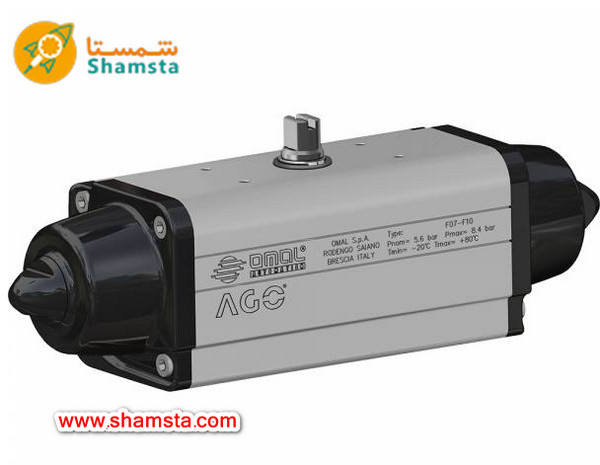
This type of actuator creates movement using special materials that deform under the influence of electric current. They are very similar to the function of the body's muscles and are currently being researched in the field of robotics and artificial limb construction. Artificial Muscle Actuator is a new type of actuator that is designed with inspiration from the function of the human body's muscles. This type of actuator creates movement using special materials that deform under the influence of electric current. Actuators convert a control signal from a control system (such as a PLC or digital controller) into mechanical movement. These signals can be electrical, hydraulic or pneumatic. An artificial muscle actuator is made of polymer or composite materials that contract or expand under the influence of electric current. This deformation can be converted into linear or rotational movement
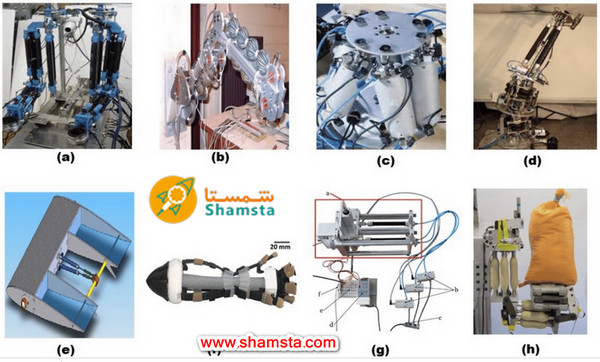
Thermal actuators are a type of actuator that uses temperature changes to create mechanical movement. These devices usually operate based on the expansion and contraction of certain materials such as wax, metals with a high coefficient of expansion, or thermal fluids. Thermal actuators are used in certain control systems that are sensitive to temperature changes because they can operate without the need for external energy sources. Types of thermal actuators include wax actuators, metallic actuators, and fluidic actuators.
Automatic heating and cooling systems
Temperature control systems in vehicles
Temperature-sensitive industrial equipment
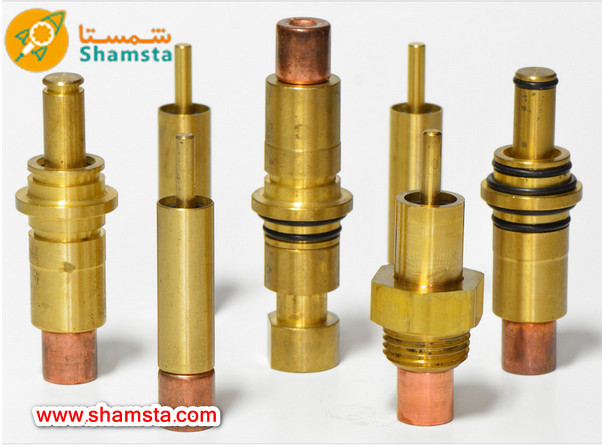
Not only are smart actuators capable of mechanical movement, they can also collect performance data and send it to control systems. These actuators are often integrated with Internet of Things (IoT) and artificial intelligence (AI) systems. Actuators are devices that convert energy (usually electrical, hydraulic, or pneumatic) into mechanical movement. But smart actuators are different from their traditional counterparts. These actuators are not only capable of performing mechanical tasks, but they can also collect data and communicate with smart control systems. This feature makes them much more efficient and flexible in modern industrial environments.
Ability to connect with automatic control systems
Collection and analysis of performance data
High accuracy and efficiency
Advanced industries such as robotics and automotive
Smart production lines
Energy management systems
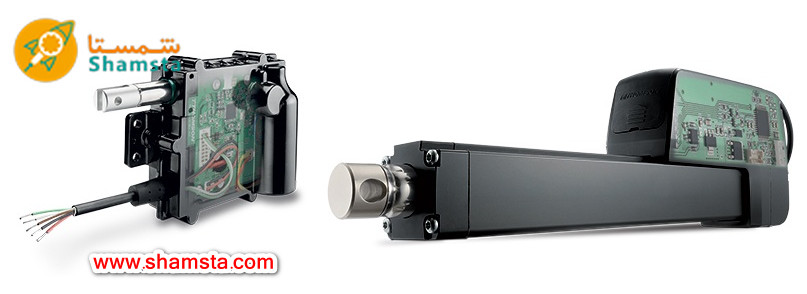
Read more: tundish nozzle material
Manual and mechanical actuators are simple and basic types of actuators that are used to convert human power or mechanical energy into motion. These actuators are used in many industrial and everyday applications due to their simplicity, high reliability, and lack of need for external energy sources. Manual actuators are completely dependent on human power and are controlled by turning, pushing, or pulling mechanical parts. These actuators are very suitable for applications that require low power or simple controls.
The features of manual actuators include simplicity in design and operation, very low cost, and human control. These actuators are used in industrial valves, hand tools, and doors and windows.
:The following are the components that make up the actuator body
Motor: The motor is one of the main components of electric actuators that converts electrical energy into mechanical motion. Depending on the type of actuator, the motor may be an electric motor (used in electric actuators), a hydraulic motor (used in hydraulic actuators), and a pneumatic motor (used in pneumatic actuators using compressed air pressure):
Piston and Cylinder: The piston and cylinder are one of the main components of hydraulic and pneumatic actuators. Fluid or compressed air enters the cylinder and causes the piston to move, which in turn converts this movement into mechanical movement.
Gears: In some actuators (especially electrical and mechanical), gears are used to convert or amplify motion. Gears help regulate speed, increase torque, and change direction of motion.
Types of gears include worm gears for reducing speed and increasing torque, and planetary gears for distributing power to multiple axes.
Spring: Springs are used in many actuators to provide a return force and store energy. For example, in some mechanical actuators, springs help return parts to their original position after a movement.
Valves and Pumps: In hydraulic and pneumatic actuators, valves and pumps play an important role in controlling the flow of fluid or air. These components regulate how and at what pressure the fluid enters the system and exerts pressure on the piston. Among the main components:
Shaft: Shafts are parts that in actuators transmit rotary or linear motion from the motor to other parts of the system. In electrical or mechanical actuators, shafts are usually connected to gears or other mechanisms to transmit motion outside the actuator.
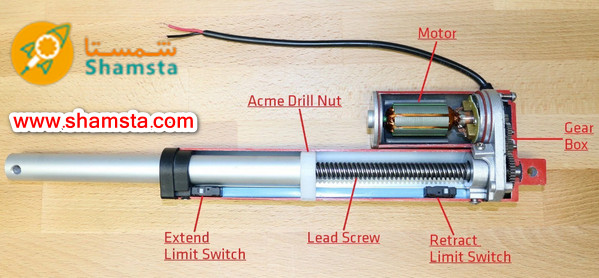
Control System: Many actuators are equipped with control systems that allow the user to control and monitor the movement and performance of the actuator. These systems can be simple (manual) or complex and automated.
Types of control systems include manual control (using an actuator handle or button) or electrical control (using electrical or computer systems for precise control).
Motion Mechanism: This part of the actuator is designed to convert the motion generated by the motor or fluid pressure into linear or rotary motion. The motion mechanism varies depending on the type of actuator. In electric actuators, a lead screw mechanism is used to convert rotary motion to linear motion, and in rotary actuators, a rotary mechanism amplifies the rotary motion of the motor and transmits it to the system.
Sensors: In smart and automated actuators, sensors play a vital role in precise motion control. Sensors measure data such as position, speed, pressure, and temperature and send them to the control system. These sensors include position, pressure, and temperature sensors
:Actuators are used in various industries and applications, including
Automotive industry: In the automotive industry, actuators are used to control valves and throttle valves, brake and clutch systems, seat and mirror adjustments, etc.
Robotics: Actuators are used to move robot joints, handling and transportation systems, precise assembly and welding operations, etc.
Oil and gas industries: Actuators are used to control valves and gates, drilling systems, and transfer and storage equipment in the oil and gas industries.
Food and pharmaceutical industries: Actuators are used for packaging and labeling, cleaning and washing equipment, and controlling production processes.
Energy industries: Actuators are used to control turbines and generators, non-renewable energy production systems, and energy transmission and distribution equipment.
Conclusion
Actuators play a very important role in industrial and mechanical systems. Choosing the right type of actuator according to different needs and applications can help improve system performance and increase productivity. Given the different types and features of actuators, they can be used in different industries and achieve the desired goals.
Recommended articles: Introduction to types of metal barrels in industry